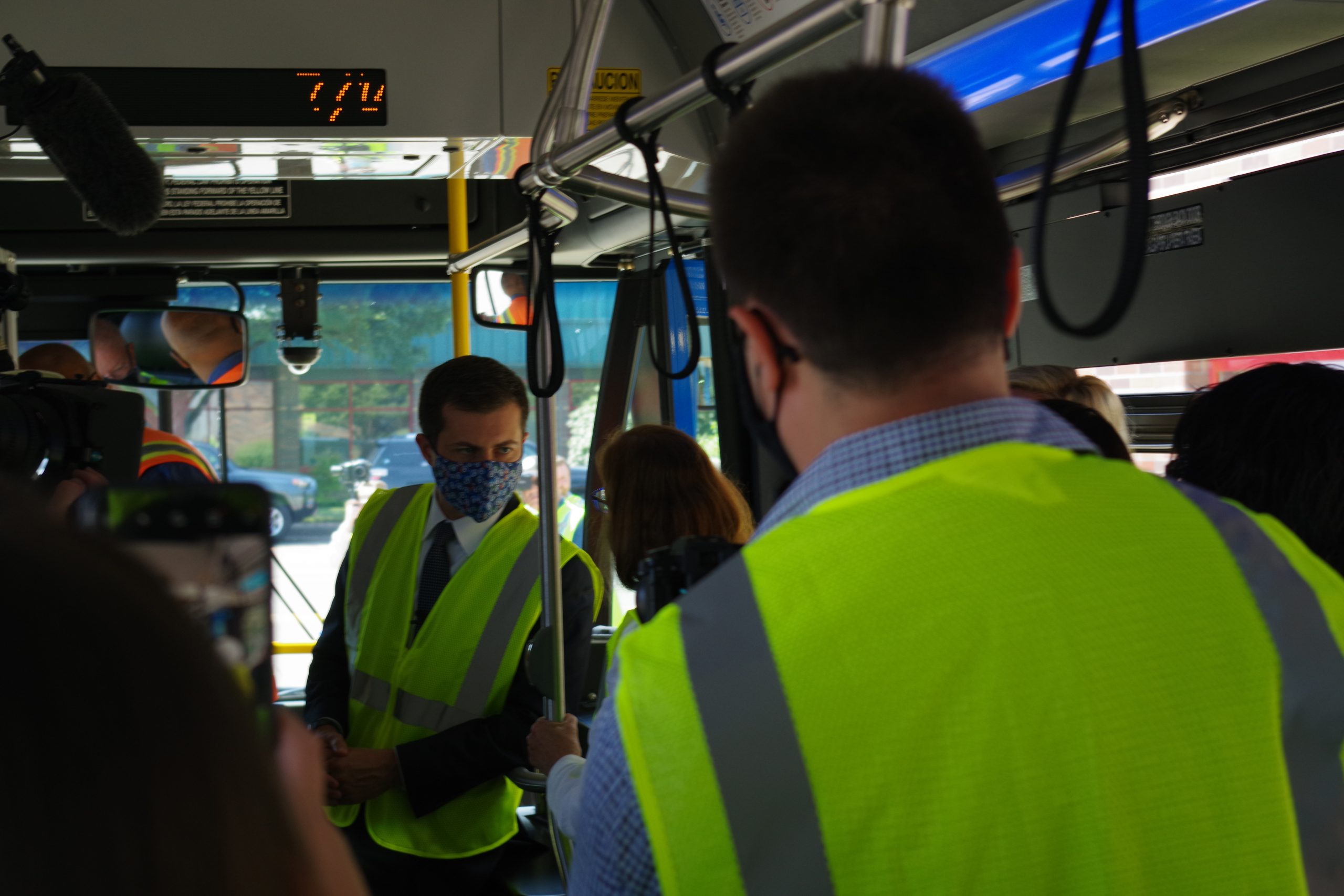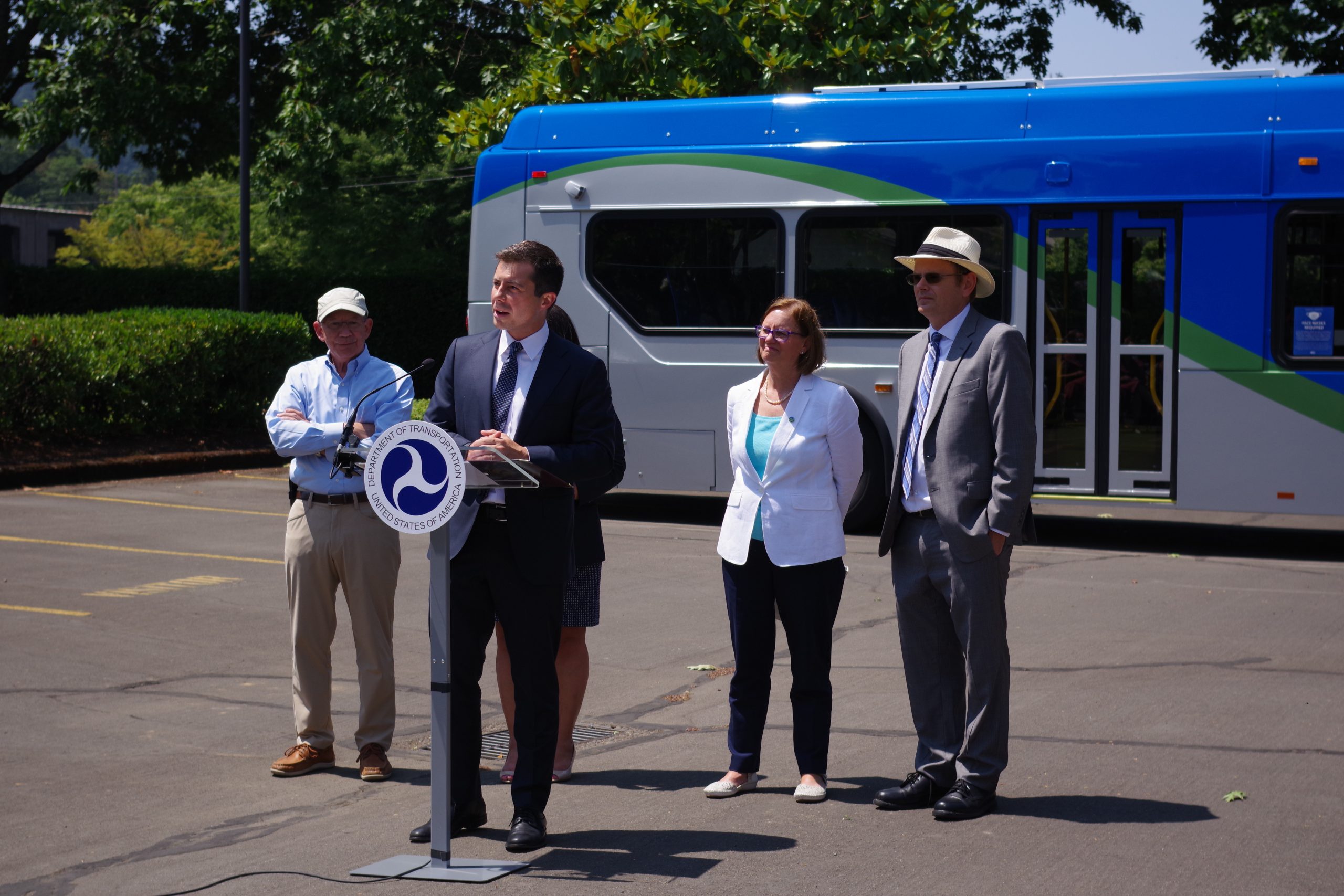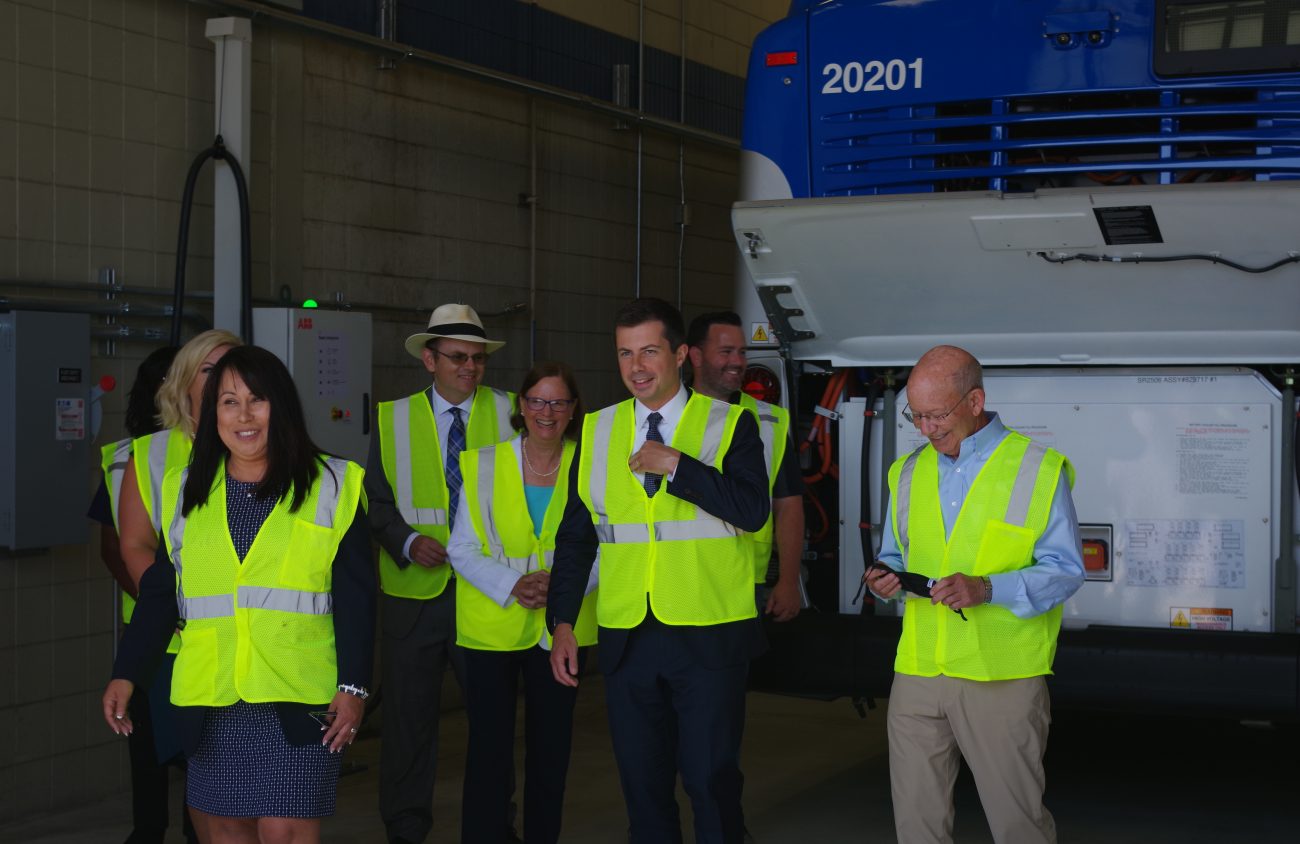The Lane Transit District blue electric bus jolts forward when Congressman Peter DeFazio, sitting in the driver’s seat, accelerates in LTD’s parking bay.
He circles the LTD headquarters in Springfield, only slamming the brakes occasionally, and parks the bus back to the parking spot.
“Who’s next?” an LTD employee asks.
Secretary of Transportation Pete Buttigieg is next. After being taught the fundamentals, he honks the horn a few times and drives around the parking lot.
The two politicians aren’t filming a reboot of the blockbuster Speed series. House Transportation and Infrastructure Chair DeFazio and Buttigieg drove LTD’s new electric buses and discussed the need for legislative investments into infrastructure that they say will address climate change. It was their second Oregon visit in one day — their previous stop in Corvallis was focused on traffic safety and decreasing pedestrian death from cars.
Both Buttigieg and DeFazio tell Eugene Weekly that President Joe Biden’s $1.2 trillion Bipartisan Infrastructure Framework and DeFazio’s $767 billion, which DeFazio says is the “first implementation of the Green New Deal,” will cut U.S.’s greenhouse gas emissions and create new clean energy jobs.

Breaking Up With Fossil Fuel
“This is a unique moment. I’ve been waiting for this for a very, very, long time. I’ve spent my whole career in Congress on [the Transportation and Infrastructure] committee,” DeFazio said at the press conference about his bill and Biden’s legislative package, which totals nearly $2 trillion investment in infrastructure. “This is the time to bring America into the 21st century.”
The near $2 trillion infrastructure investments includes the Biden administration’s $1.2 trillion infrastructure package that is a part of the president’s $3.5 trillion budget package, which includes boosting Medicare benefits and other safety net services. And there’s DeFazio’s $767 billion bill “Investing in a New Vision for the Environment and Surface Transportation in America Act” (or INVEST in America Act), which is now in the Senate.
“It’s not going to be Eisenhower 8.0,” DeFazio said. “It’s going to be for the 21st century.” President Dwight D. Eisenhower’s infrastructure plan, he added, was for quick evacuation from the existential threats at the time: invasion and nuclear war. “We have a new existential threat, and it’s climate change.”
The Biden legislative package includes $7.5 billion for electric buses throughout the U.S., according to a June 24 White House fact sheet. And DeFazio’s bill would provide money to make 100 percent of the nation’s buses electric, according to a July 14 press release from his office.
One revenue source that would fund the Biden transportation package will come from reducing the IRS gap, the difference between how much is owed to the agency and the amount that is collected, according to the June 24 fact sheet.
The status of Biden’s $3.5 trillion budget reconciliation package that includes $1.2 trillion for infrastructure is still being negotiated in the Senate, as of July 15. Since it’s being pushed as budget reconciliation, the Republicans would be unable to filibuster the legislation which would have otherwise killed it.
The Bipartisan Legislative Framework is in Congress at a time when Oregon is reminding the country of the impacts of climate change, Buttigieg said at the press conference. From people fleeing wildfires to roads warping during a recent heatwave, “Things that we have talked about as maybe happening in the middle of the century, instead happened last week,” he said.
DeFazio said his bill and Biden’s infrastructure legislative package provides money to support growing U.S. clean energy industries. LTD is increasing the number of electric buses, many of which were made in Alabama, DeFazio said. He added that the American-made electric buses are better than those made by a “Chinese Communist government company,” which LTD purchased several years ago.
“They were crap, and they got sent back,” DeFazio said. “We now have buses that were made here, in the United States of America.”
The Springfield press conference featured speeches by Eugene Mayor Lucy Vinis and Springfield Mayor Sean VanGordon. In attendance included Lane County Chair Joe Berney, County Commissioner Heather Buch, Eugene City Councilors Greg Evans and Matt Keating, Eugene City Manager Sarah Medary and various union representatives.

Buttigieg Talks Biden Infrastructure Plan
The Biden administration’s sponsored bill includes money to build electric vehicle charging stations at National Parks and rural and low-income communities. “These are areas where it’s not automatically economic for a private company to do it,” Buttigieg tells Eugene Weekly. “This is very important from a social equity perspective because we can’t just have chargers in the middle of the most profitable locations and have a full national network.”
He adds that the Senate is considering ways to make electric vehicles more affordable. “And that’s important for low-income drivers who will benefit most from the fuel savings,” he says. “But you have to deal with upfront costs.”
The global temperature has already risen to an average 1 degree Celsius compared to pre-Industrial Age temperatures and is projected to go to 1.5C° between 2030 and 2050, according to the Intergovernmental Panel on Climate Change’s 2018 report.
“Every transportation decision is a climate decision,” Buttigieg says, “making it easier to walk or bike to get around is part of that. A lot of that comes down to safety, which is why I’m glad about $10 billion for safety.”
The Biden administration infrastructure bill, if passed, will allow pedestrians and motor vehicle drivers to share the streetscape. “For those who are driving, making sure that it’s possible to do so in a zero emission vehicle,” he adds.
Buttigieg says he hasn’t seen a specific number of how much greenhouse gas emissions will be cut from Biden’s Bipartisan Infrastructure Framework. But since the transportation sector is responsible for the most amount of greenhouse gas emissions, he adds, it’s the first place to tackle.
But it’s not the only large chunk. According to the U.S. Environmental Protection Agency’s 2019 greenhouse gas inventory data, transportation is 29 percent of the pie. The two next big chunks are electricity (25 percent) and industry (23 percent).
“A lot of it goes into the energy mix, which goes into industrial and residential,” he says. “That’s why we’re proud that even this bill contains the biggest investment in clean energy transmission we’ve ever had as a country.”
Biden initially pushed for a $2 trillion infrastructure plan, but that amount was nearly halved to recruit Republican support.
“We presented all of these ideas at once and found there was a subset that we could do on a bipartisan basis, and the president prefers to work on a bipartisan basis when he can,” Buttigieg says.
There might be other ways the Biden administration can green more energy sources, Buttigieg says. He refers to Biden’s April 23 climate summit he hosted at the White House with 40 world leaders, where he committed to a “very aggressive goal,” Buttigieg says, as well as rejoining the Paris Climate Agreement.

Making Cities Safe and Breathable
Before driving LTD’s electric bus around a parking lot, Buttigieg and DeFazio visited Corvallis to speak with Oregon Department of Transportation Director Kris Strickler and Corvallis Mayor Bill Traber about road safety for pedestrians and cyclists.
“Unfortunately, a little girl was just killed there trying to cross a street,” DeFazio said at the Springfield press conference. “In too many places around the country in the automobile era, we design everything for automobiles with no thought toward pedestrians. No thought to cycling or alternative modes.”
He added, “We divided communities of color, and that was done in many places intentionally.”
He said his INVEST in America Act will make streets safer, referencing the term “complete streets,” a policy where streets must be designed to be safe for pedestrians and motor traffic. According to a July 14 press release from DeFazio’s office, over five years, the bill spends $108 million for carbon pollution reduction, $81 million for pre-disaster mitigation, $120 million for congestion mitigation and air quality improvement and $76 million for bike and pedestrian transportation options.
“My new bill encourages that states use materials that are less polluting in their production,” DeFazio tells EW. “They’ve actually invented carbon negative concrete now. Concrete is 7 percent of our carbon footprint and we could easily move that to three and a half in the future. And we can move to carbon with a negative footprint that will absorb carbon.”
INVEST in America passed the House, 221-201, and is in the Senate.
“My bill is the first implementation of the Green New Deal,” he says. “Although Republicans call it the Green New Deal 2.0.”
One of the programs that could be funded by the program is Safe Routes to School, which encourages K-12 students to walk or ride their bikes to school by improving infrastructure. He says he tried to secure $4 billion for the program when Republicans were in power, but they killed it. Now, he’s doubled the money for the program and other bike infrastructure, such as protected bike lanes.
“We are seeing a big uptick in pedestrian and cycling deaths, especially now with people driving these gigantic, useless pickup trucks,” he says. “The chance of a fatal crash has gone up astronomically if you’re hit by one of those things as opposed to a regular vehicle.”
DeFazio adds that safety money will be spread throughout the U.S., including areas that don’t have any bike infrastructure.
“If we want to get more people out of their cars, we gotta make it more convenient and safe,” he tells EW. “In a lot of places it isn’t safe. So people are like, “I’d like to ride my bike, but it’s not safe. I’m not divided from traffic.’”
Because of the large amount of greenhouse gas emissions produced in the transportation sector, DeFazio says the Biden administration infrastructure package puts in a “record investment” in micro-transit options, which includes infrastructure for pedestrians, cyclists and scooters.
